
Technical indicators are used by traders to gain insight into the supply and demand of securities and market psychology. Together, these indicators form the basis of technical analysis. Metrics, such as trading volume, provide clues as to whether a price move will continue. In this way, indicators can be used to generate buy and sell signals. In this list, you’ll learn about seven technical indicators to add to your trading toolkit. You don’t need to use all of them, rather pick a few that you find helpful in making better trading decisions.
Tools of the Trade
The tools of the trade for day traders and technical analysts consist of charting tools that generate signals to buy or sell, or which indicate trends or patterns in the market. Broadly speaking, there are two basic types of technical indicators:
- Overlays: Technical indicators that use the same scale as prices are plotted over the top of the prices on a stock chart. Examples include moving averages and Bollinger Bands or Fibonacci lines.
- Oscillators: Rather than being overlaid on a price chart, technical indicators that oscillate between a local minimum and maximum are plotted above or below a price chart. Examples include the stochastic oscillator, MACD, or RSI. It will mainly be these second kinds of technical indicators that we consider in this article.
Traders often use several different technical indicators in tandem when analyzing security. With literally thousands of different options, traders must choose the indicators that work best for them and familiarize themselves with how they work. Traders may also combine technical indicators with more subjective forms of technical analysis, such as looking at chart patterns, to come up with trade ideas. Technical indicators can also be incorporated into automated trading systems given their quantitative nature.
On-Balance Volume
First up, use the on-balance volume indicator (OBV) to measure the positive and negative flow of volume in a security over time.
The indicator is a running total of up volume minus down volume. Up volume is how much volume there is on a day when the price rallies.
Down volume is the volume on a day when the price falls. Each day volume is added or subtracted from the indicator based on whether the price went higher or lower.
When OBV is rising, it shows that buyers are willing to step in and push the price higher. When OBV is falling, the selling volume is outpacing buying volume, which indicates lower prices. In this way, it acts like a trend confirmation tool. If price and OBV are rising, that helps indicate a continuation of the trend.
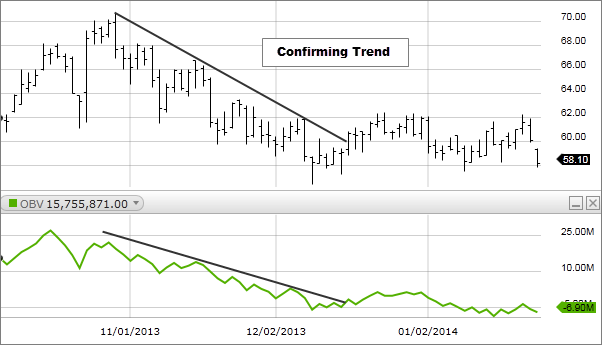
Traders who use OBV also watch for divergence. This occurs when the indicator and price are going in different directions. If the price is rising but OBV is falling, that could indicate that the trend is not backed by strong buyers and could soon reverse.
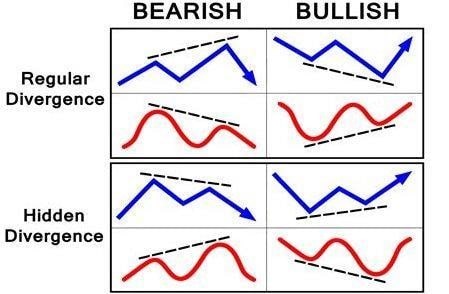
Accumulation/ Distribution Line
One of the most commonly used indicators to determine the money flow in and out of a security is the accumulation/distribution line (A/D line).
It is similar to the on-balance volume indicator (OBV), but instead of considering only the closing price of the security for the period, it also takes into account the trading range for the period and where the close is in relation to that range. If a stock finishes near its high, the indicator gives volume more weight than if it closes near the midpoint of its range. The different calculations mean that OBV will work better in some cases and A/D will work better in others.
If the indicator line is trending up, it shows buying interest, since the stock is closing above the halfway point of the range. This helps confirm an uptrend. On the other hand, if A/D is falling, that means the price is finishing in the lower portion of its daily range, and thus volume is considered negative. This helps confirm a downtrend.
Traders using the A/D line also watch for divergence. If the A/D starts falling while the price is rising, this signals that the trend is in trouble and could reverse. Similarly, if the price is trending lower and A/D starts rising, that could signal higher prices to come.
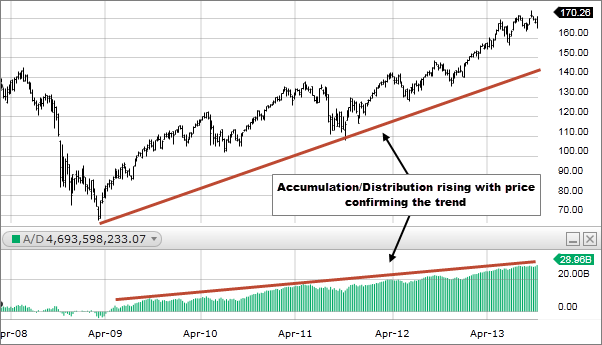
Average Directional Index
The average directional index (ADX) is a trend indicator used to measure the strength and momentum of a trend. When the ADX is above 40, the trend is considered to have a lot of directional strength, either up or down, depending on the direction in the price is moving.
When the ADX indicator is below 20, the trend is considered to be weak or non-trending.
The ADX is the main line on the indicator, usually coloured black. There are two additional lines that can be optionally shown. These are DI+ and DI-. These lines are often coloured red and green, respectively. All three lines work together to show the direction of the trend as well as the momentum of the trend.
- ADX above 25 and DI+ above DI-: That’s an uptrend.
- ADX above 25 and DI- above DI+: That’s a downtrend.
- ADX below 25 is a weak trend or ranging period, often associated with the DI- and DI+ rapidly crisscrossing each other.
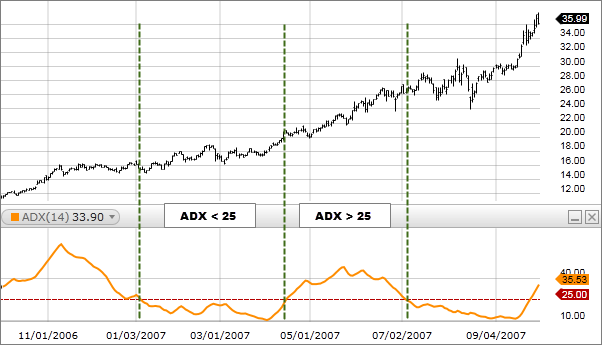
Aroon Indicator
The Aroon oscillator is a technical indicator used to measure whether a security is in a trend, and more specifically if the price is hitting new highs or lows over the calculation period (typically 25).
The indicator can also be used to identify when a new trend is set to begin. The Aroon indicator comprises two lines: an Aroon Up line and an Aroon Down line.
When the Aroon Up crosses above the Aroon Down, that is the first sign of a possible trend change. If the Aroon Up hits 100 and stays relatively close to that level while the Aroon Down stays near zero, that is positive confirmation of an uptrend.
The reverse is also true. If Aroon Down crosses above Aroon Up and stays near 100, this indicates that the downtrend is in force.
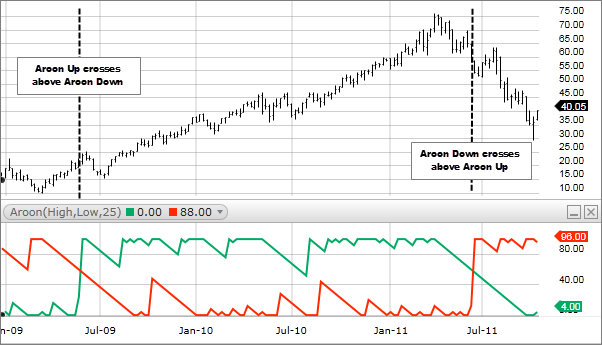
MACD
The moving average convergence divergence (MACD) indicator helps traders see the trend direction, as well as the momentum of that trend. It also provides a number of trade signals.
When the MACD is above zero, the price is in an upward phase. If the MACD is below zero, it has entered a bearish period.
The indicator is composed of two lines: the MACD line and a signal line, which moves slower. When MACD crosses below the signal line, it indicates that the price is falling. When the MACD line crosses above the signal line, the price is rising.
Looking at which side of zero the indicator is on aids in determining which signals to follow. For example, if the indicator is above zero, watch for the MACD to cross above the signal line to buy. If the MACD is below zero, the MACD crossing below the signal line may provide the signal for a possible short trade.
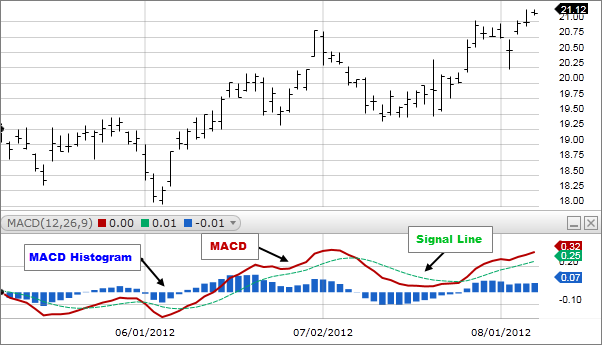
Relative Strength Index
The relative strength index (RSI) has at least three major uses. The indicator moves between zero and 100, plotting recent price gains versus recent price losses. The RSI levels, therefore, help in gauging momentum and trend strength.
The most basic use of an RSI is as an overbought and oversold indicator. When RSI moves above 70, the asset is considered overbought and could decline. When the RSI is below 30, the asset is oversold and could rally. However, making this assumption is dangerous; therefore, some traders wait for the indicator to rise above 70 and then drop below before selling, or drop below 30 and then rise back above before buying.
Divergence is another use of the RSI. When the indicator is moving in a different direction than the price, it shows that the current price trend is weakening and could soon reverse.
A third use for the RSI is support and resistance levels. During uptrends, a stock will often hold above the 30 levels and frequently reach 70 or above. When a stock is in a downtrend, the RSI will typically hold below 70 and frequently reach 30 or below.
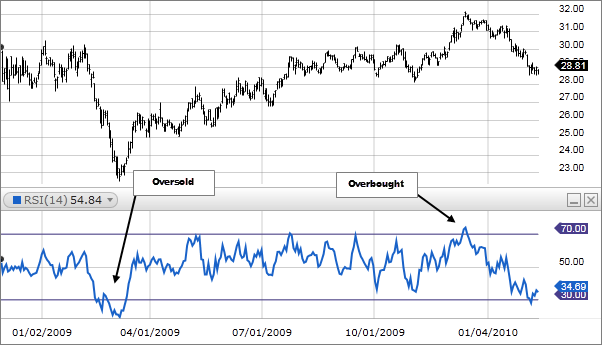
Stochastic Oscillator
The stochastic oscillator is an indicator that measures the current price relative to the price range over a number of periods. Plotted between zero and 100, the idea is that, when the trend is up, the price should be making new highs. In a downtrend, the price tends to make new lows. The stochastic tracks whether this is happening.
The stochastic moves up and down relatively quickly as it is rare for the price to make continual highs, keeping stochastic near 100, or continual lows, keeping stochastic near zero. Therefore, stochastic is often used as an overbought and oversold indicator. Values above 80 are considered overbought, while levels below 20 are considered oversold.
Consider the overall price trend when using overbought and oversold levels. For example, during an uptrend, when the indicator drops below 20 and rises back above it, that is a possible buy signal. But rallies above 80 are less consequential because we expect to see the indicator move to 80 and above regularly during an uptrend. During a downtrend, look for the indicator to move above 80 and then drop back below to signal a possible short trade. The 20 level is less significant in a downtrend.
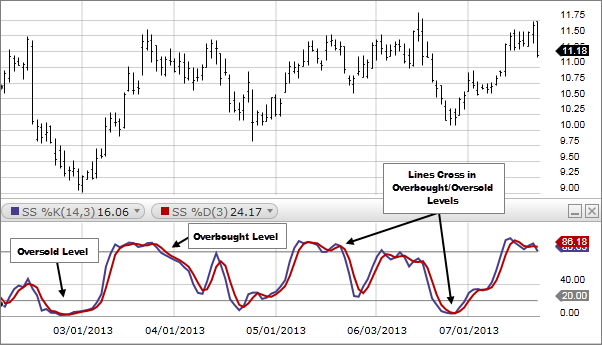
Reliability of Technical Analysis
Technical analysis is the reading of market sentiment via the use of graph patterns and signals. Various empirical studies have pointed to its effectiveness, but the range of success is varied and its accuracy remains undecided. It is best to use a suite of technical tools and indicators in tandem with other techniques like fundamental analysis to improve reliability.
Best Spot Overbought/Oversold Conditions
The relative strength index (RSI) is among the most popular technical indicators for identifying overbought or oversold stocks. The RSI is bound between 0 and 100. Traditionally, a reading above 70 indicates overbought ad below 30 oversold.
Number of Technical Analysis Tools
There are several dozen technical analysis tools, including a range of indicators and chart patterns. Market technicians are always creating new tools and refining old ones.
The goal of every short-term trader is to determine the direction of a given asset’s momentum and to attempt to profit from it. There have been hundreds of technical indicators and oscillators developed for this specific purpose, and this article has provided a handful that you can start trying out. Use the indicators to develop new strategies or consider incorporating them into your current strategies. To determine which ones to use, try them out. Pick the ones you like the most, and leave the rest.
Financial and Business expert having 30+ Years of vast experience in running successful businesses and managing finance.





